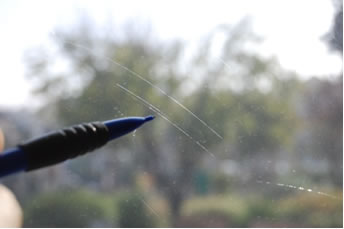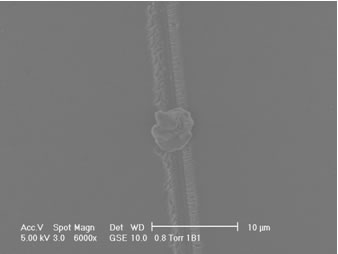Window Glazing Scratches
 Figure 1. Scratches in the window glazing. Figure 1. Scratches in the window glazing.
Figure 2. 6000X scanning electron microscope micrograph of a particle of stucco. |
Shortly after some newly installed windows were cleaned, the building owner noticed scratches in the glazing as seen in Figure 1. Window cleaning contractors typically use razor blade type scrapers to remove debris not easily cleaned away in the washing process. So it was suspected that the scratches might have been caused by the hardened steel blades used during a recent cleaning. Because of the extent of the damage, the glazing on several windows was removed and replaced. We obtained the glazing from one of the removed windows for further detailed examination and testing to determine the root cause of the scratches.
Examination to determine the root cause of damage such as this usually requires the use of a microscope. Damage to materials caused by external forces usually leaves distinctive markings and features that can help identify the source of the loading. In this case the resulting damage is a surface scratch, and Figure 2 shows an area of damage to the glazing magnified 6000X using a scanning electron microscope (SEM). Visible under this magnification is the scratch as well as distinctive parallel line features near its edges; also visible is a piece of debris still embedded in the scratch.
Many SEMs have an integrated feature called x-ray energy dispersive spectroscopy (EDS). This is an analytical technique used for the elemental analysis or chemical characterization of a sample. In this case we were interested in the chemical composition of the small piece of debris embedded in the scratch. EDS revealed high levels of elemental calcium and sulfur present in the debris particle. There were reports of ongoing construction of a building nearby, where finishing stucco had just been placed. The elemental analysis of the debris particle is consistent with hydrated calcium sulfate, commonly known as gypsum and a constituent of Portland cement used as a raw material in stucco.

